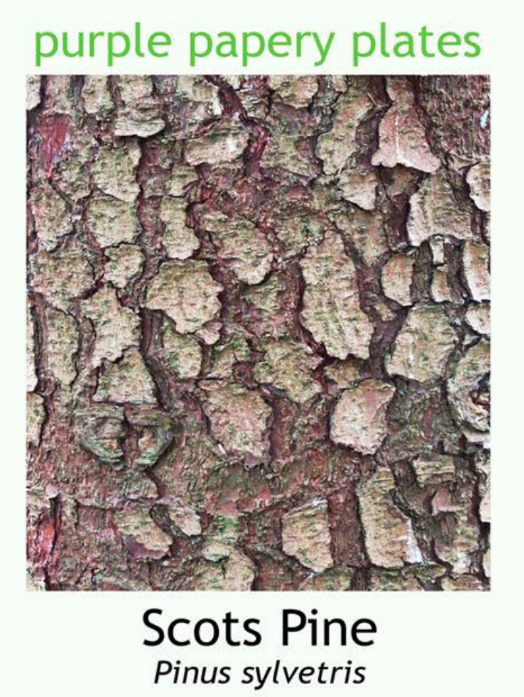Recognising the Scots Pine Tree:
-
Needles: The Scots Pine tree has evergreen needles that are arranged in pairs and are bluish-green to dark green in colour. The needles are slender, flexible, and measure around 4-7 centimetres in length.
-
Bark: The bark of the Scots Pine tree is reddish-brown to orange-brown and becomes more scaly and furrowed with age. Younger trees may have smoother bark, while older trees develop rough, irregular plates.
-
Cones: Scots Pine trees produce oval-shaped cones that are typically reddish-brown when mature. The cones have thick, woody scales and contain small, winged seeds.
-
Shape: Scots Pine trees have a distinctive conical or pyramidal shape, with a straight trunk and spreading branches that form a broad crown. They can grow to significant heights, with some specimens reaching over 30 meters tall.
-
Habitat: Scots Pine trees are commonly found in a variety of habitats, including forests, woodlands, heathlands, and upland areas. They are often associated with acidic soils and tolerate a wide range of environmental conditions.


5 Interesting Facts about the Scots Pine Tree:
-
Longevity: Scots Pine trees are long-lived, with some specimens living for several hundred years. They are among the oldest living organisms in Ireland and have witnessed centuries of history and environmental change.
-
Ecosystem Engineer: Scots Pine trees play a key role in shaping and maintaining forest ecosystems. They provide habitat and food for a wide range of wildlife species, contribute to soil stabilisation and nutrient cycling, and help regulate local climate and hydrology.
-
Fire Adaptation: Scots Pine trees are adapted to survive and even benefit from wildfires. Their thick, fire-resistant bark helps protect the cambium layer from heat and flames, allowing the tree to recover and regenerate after a fire. Additionally, some Scots Pine cones require the heat of a fire to open and release their seeds, promoting new growth and regeneration in fire-adapted ecosystems.
-
Historical Uses: Scots Pine wood has been used historically for a variety of purposes, including construction, shipbuilding, furniture making, and fuel wood. It is valued for its strength, durability, and attractive grain pattern, making it a versatile and valuable timber species.
-
Symbolism: Scots Pine trees have cultural and symbolic significance in Celtic, Norse, and other European traditions. They have been associated with strength, resilience, and longevity, and have been used as symbols of national identity and pride in Scotland and other countries where they are native.
Uses of the Scots Pine Tree:
-
Timber: Scots Pine wood is highly valued for its strength, durability, and versatility. It is used in a wide range of applications, including construction (e.g., timber framing, roofing, flooring), furniture making, joinery, fencing, and pulp and paper production.
-
Resin Production: Scots Pine trees produce resin, or pitch, which has been traditionally used for waterproofing, sealing, and adhesive purposes. Historically, pine resin was used to seal wooden boats, barrels, and joints, as well as for making torches, candles, and varnishes.
-
Wildlife Habitat: Scots Pine trees provide valuable habitat and food for a variety of wildlife species. Their dense foliage and branching structure provide shelter and nesting sites for birds, mammals, and insects, while their seeds are an important food source for birds and small mammals.
Contribution to Biodiversity:
-
Habitat Provider: Scots Pine trees contribute to biodiversity by providing habitat and food for a wide range of wildlife species. Their presence enhances habitat complexity and supports populations of birds, mammals, insects, and other organisms in forests, woodlands, and upland areas.
-
Soil Stabilisation: The extensive root system of Scots Pine trees helps stabilise soil, prevent erosion, and improve soil structure. This contributes to the health and stability of forest ecosystems, particularly in upland and mountainous regions where soils may be prone to erosion.
-
Nutrient Cycling: Scots Pine trees play a role in nutrient cycling by absorbing carbon dioxide from the atmosphere and releasing oxygen through photosynthesis. They also cycle nutrients through their needles, branches, and roots, contributing to soil fertility and ecosystem productivity.
In summary, the Scots Pine tree is recognisable by its bluish-green needles, reddish-brown bark, and distinctive conical shape. It holds cultural significance, provides valuable resources for wildlife, and contributes to biodiversity and ecosystem health in Ireland's forests, woodlands, and upland areas. Additionally, it serves as a source of timber, resin, and wildlife habitat, supporting a wide range of plant and animal species in natural ecosystems.
Images taken from the beautiful posters created by Phil Barnett and you can download these and/or purchase other great designs from his online shop.
